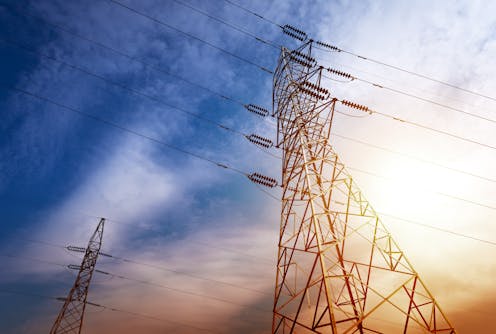Wholesale power prices are falling fast – but consumers will have to wait for relief. Here’s why
- Written by Tony Wood, Program Director, Energy, Grattan Institute

Wholesale power prices are falling steeply in Australia, following two years of surging prices after the Ukraine war triggered an energy crisis. New data shows annualised spot prices for power in Australia’s main grid fell by about 50% in 2023. That brings the cost of wholesale power down towards the levels seen in 2021.
Is that good news for consumers? It will be – but not yet. Energy retailers buy most of their power in advance at set prices, accepting higher average prices for less volatility. That means the cheaper spot prices won’t flow through to you for a while. But they will.
Here’s how the system works.
Read more: Surging energy prices are really going to hurt. What can the government actually do?
How is power priced?
The way we price electricity will be different depending where you live in Australia.
If you live in Tasmania, Western Australia, regional Queensland or in the Northern Territory, there’s no competition. The state or territory government runs the power system, and prices are set by a regulator.
In South Australia, Victoria, New South Wales, and south-east Queensland, the competitive National Energy Market applies. Here, retailers buy power on the wholesale spot market from generators and compete for your business by offering different prices and bundling electricity with other services such as gas or broadband. (Some energy companies are both generators and retailers.)
While the federal government doesn’t set prices in the market, it does have some involvement. In 2019, it introduced a mandatory default market offer, effectively setting a maximum price a retailer can charge customers. Victoria also implemented its own default offer. These changes stemmed from concerns retail competition was overly complicated and not delivering benefits to all electricity consumers.
Default offers were intended as a fair price for power and to work as a safety net so consumers weren’t overcharged.
Retailers compete in part by offering deals set below the default price. Nearly all of us have now signed up for market offers, leaving fewer than 10% of consumers still on a default offer.
The price of electricity in default offers is set by energy regulators, usually on 1 July each year. Competing retailers tend to mirror changes to the default offers in their market offers. That means most, if not all, consumers should start seeing lower default prices reflected in their bills from this date onwards.
But don’t expect falling wholesale prices to be passed on immediately or in full. Buying electricity wholesale is only around 40% of a retailer’s total cost. Retailers also pass through the costs of transmission and distribution.
Ironing out fluctuations
In the National Energy Market, the spot price of power changes every five minutes – often drastically. Prices can be as low as negative A$1,000 per megawatt hour or as high as +$16,000 a megawatt hour if there are outages or intense demand during a heatwave. (Prices can turn negative if there’s an oversupply of power, such as when millions of rooftop solar arrays are putting energy into the grid in the middle of the day, and act as an incentive to boost demand or cut supply.)
You and I don’t want to be exposed to such price volatility. We rely on our retailers to do it, and they do so by taking out multi-year contracts to smooth out the price of power.
That means we are not exposed immediately to sudden increases in price, but it also means we do not benefit from rapid falls. Retail prices, including default offers, will respond to changes in wholesale prices when those changes are reflected in the retailers’ contract prices.
What about politics?
Power prices are political. Everyone uses electricity and bill shock hurts.
At present, the Albanese government is under real pressure over the cost of living. Successive interest rate rises and more expensive petrol and groceries have left many of us feeling poorer.
Could there be direct intervention? Unlikely. Since the National Electricity Market was introduced in 1998, governments have avoided directly regulating prices.
When partial interventions are tried, they tend to have little impact. When the Coalition was in office federally, they introduced the so-called Big Stick laws, aimed at forcing energy retailers to pass on cost savings. To date, the laws have gathered dust.
What we can expect to see are calls to action. For instance, South Australia’s energy minister recently called on retailers to pass on price falls as quickly as possible.
This makes headlines and can put pressure on regulators such as the Australian Energy Regulator. We can expect the pressure of the election cycle to lead to even more calls for regulators to act.
But regulators should respond in line with their clear guidelines, rather than in response to political pressure. After all, governments have given regulators a difficult job to do: deliver fair prices in a rapidly evolving electricity market.
It would be better for the long-term interests of consumers and energy suppliers if they were allowed to get on with it.
What’s next?
As more clean energy comes into the grid, it should push wholesale prices still lower. But the energy transition isn’t as simple as substituting solar and wind for coal. Big investments in transmission and energy storage are needed to connect more renewables and maintain a reliable system. Prices could once again rise sharply if our ageing coal plants give up the ghost before there’s enough renewable generation and storage to take up the slack.
These challenges and risks were inevitable given the scale of our net-zero transition. But the recent trend towards lower prices should give us confidence that more investment in renewables and storage can cover the closure of coal to deliver a reliable, low-emissions future – without threatening affordability.
Authors: Tony Wood, Program Director, Energy, Grattan Institute





